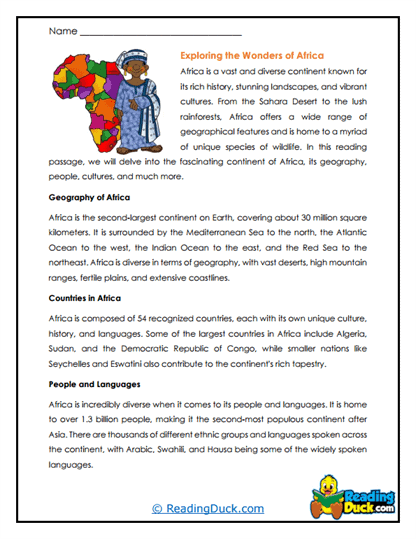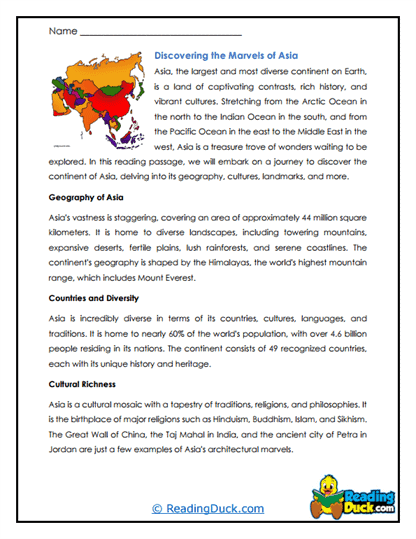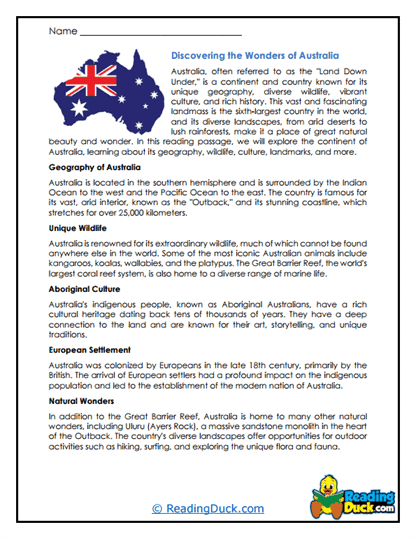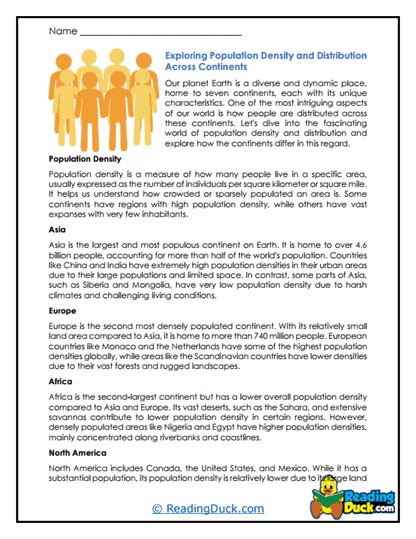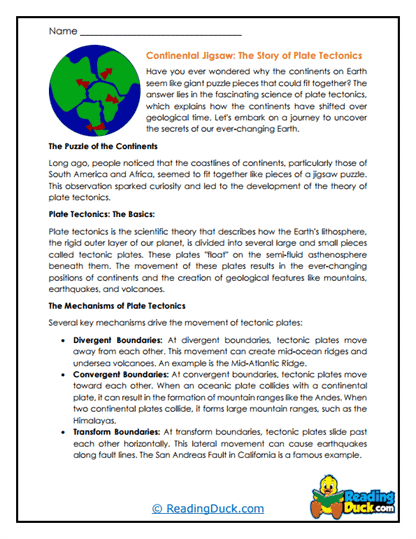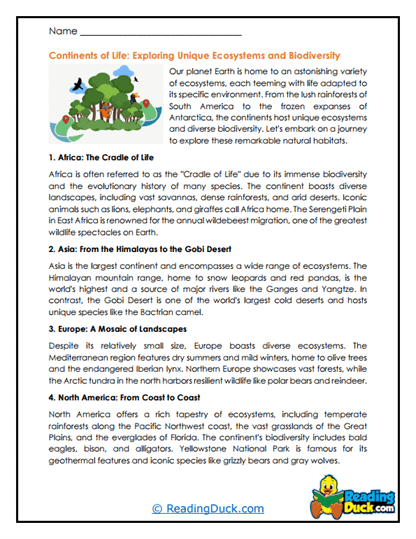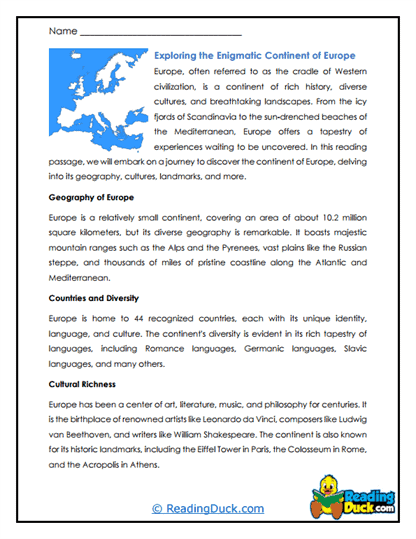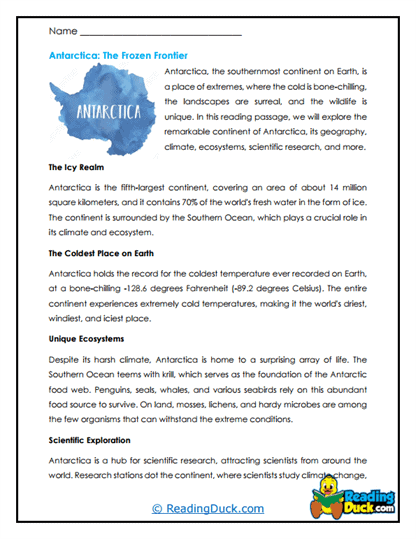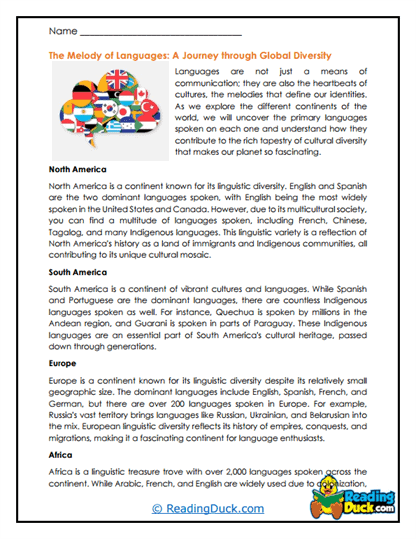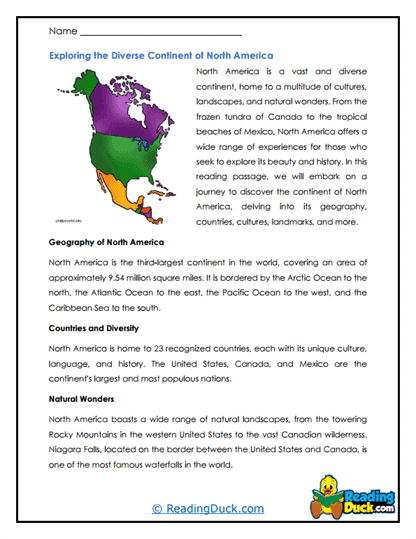Continents Worksheets
About Our Continents Worksheets
Our Continents worksheets are designed to provide students with a comprehensive understanding of the world’s seven continents. Through engaging reading passages and thought-provoking questions, these worksheets help students explore the physical, cultural, and environmental characteristics of each continent. This collection serves as a valuable resource for fostering global awareness and geographic literacy among students.
Each topic in this collection contains several worksheet sets, each thoughtfully crafted to engage students and deepen their understanding:
- Multiple Choice Questions: These questions help assess students’ comprehension of the reading passages, ensuring they grasp the key concepts related to each continent.
- Short Answer Questions: These questions encourage students to articulate their understanding in their own words, promoting deeper reflection on the unique features of each continent.
- Open-Ended Questions: These questions invite students to express their personal opinions, preferences, and insights related to the topic, fostering critical thinking and encouraging a personal connection to the material.
The worksheets are designed to be both educational and engaging, with visually appealing images that complement the text. An answer key is provided for each worksheet, making it easy for educators to assess students’ progress. All of the worksheets are available as PDF files, which can be easily viewed electronically, downloaded, and printed out for classroom or home use.
Exploring the World: Understanding Continents
When introducing the topic of continents to students, it’s essential to highlight the vast diversity and unique characteristics of each continent. Understanding continents goes beyond memorizing their names and locations; it involves exploring the rich cultural heritage, diverse ecosystems, and geographical features that make each continent distinct. Teachers should encourage students to view continents not just as landmasses, but as regions teeming with life, history, and culture.
Key Aspects of the Continents:
- South America: South America is a continent of contrasts, from the Amazon Rainforest to the Andes Mountains. Students learn about the diverse cultures, languages, and ecosystems that make South America unique, as well as its rich history and the challenges it faces today.
- Population Density Across Continents: Population density varies widely across the continents, influencing everything from urban planning to environmental sustainability. This topic helps students understand the factors that contribute to population density and how it impacts the lives of people around the world.
- Plate Tectonics: The movement of the Earth’s tectonic plates shapes the continents and their landscapes. Students explore the science behind plate tectonics, how continents have shifted over millions of years, and the impact of these movements on natural disasters like earthquakes and volcanoes.
- North America: North America is a continent of great diversity, with a wide range of climates, landscapes, and cultures. Students explore the history, geography, and cultural influences that have shaped North America, from indigenous cultures to modern-day society.
- Languages and Global Diversity: Language is a powerful tool that reflects the cultural diversity of each continent. Students learn about the various languages spoken across the continents, the role of language in shaping identity, and the importance of preserving linguistic diversity.
- Geographical Features and Landmarks on Each Continent: Each continent boasts unique geographical features and landmarks, from the Great Wall of China in Asia to the Grand Canyon in North America. This topic encourages students to explore these natural and man-made wonders, understanding their significance and the stories they tell about each continent.
- Europe: Europe is a continent steeped in history, with a rich cultural heritage that has influenced the world. Students explore the historical events, artistic movements, and political changes that have shaped Europe, as well as its role in global affairs today.
- Unique Ecosystems and Biodiversity Across the Continents: Each continent is home to unique ecosystems and species, contributing to the planet’s biodiversity. Students learn about the different habitats found on each continent, the species that inhabit them, and the importance of conservation efforts to protect these ecosystems.
- Australia: Australia is known for its unique wildlife and diverse landscapes, from the Outback to the Great Barrier Reef. Students explore the natural beauty of Australia, its indigenous cultures, and the environmental challenges it faces.
- Asia: Asia is the largest and most populous continent, with a rich tapestry of cultures, religions, and histories. Students delve into the diversity of Asia, from its ancient civilizations to its rapid modernization, and the role it plays in the global economy.
- Antarctica: Antarctica is a continent of extremes, with its harsh climate and unique ecosystems. Students learn about the scientific research conducted in Antarctica, the continent’s role in regulating the Earth’s climate, and the challenges of preserving its pristine environment.
- Africa: Africa is a continent of great cultural and ecological diversity, with a rich history that stretches back to the dawn of humanity. Students explore the landscapes, wildlife, and cultures of Africa, as well as the social and economic challenges the continent faces today.
These topics provide students with a broad understanding of the continents, encouraging them to think critically about the world around them and their place within it. By exploring the continents, students gain a deeper appreciation for the diversity of our planet and the interconnectedness of its people and environments.
The Value of Global Understanding
Learning about the continents is crucial for students of all ages, as it lays the foundation for a global perspective. In today’s interconnected world, understanding the geographical, cultural, and environmental aspects of different continents helps students become informed and responsible global citizens. This knowledge enables them to appreciate the diversity of cultures and ecosystems, recognize the shared challenges facing our planet, and contribute positively to the global community.
Furthermore, knowledge of the continents has real-world applications that extend beyond the classroom. For example, understanding population density can help students grasp the complexities of urban planning and resource management, while knowledge of plate tectonics can inform their awareness of natural disasters and their impact on communities. By studying the continents, students develop critical thinking skills, cultural sensitivity, and a sense of responsibility for the world we share. This understanding is essential not only for academic success but also for personal growth and development as they navigate an increasingly globalized world.
Integrating Continents Worksheets Across the Curriculum
To maximize the educational value of the Continents worksheets, teachers and parents can use the following strategies to incorporate them into various aspects of the curriculum:
- Social Studies Integration: Use the worksheets as a foundation for broader social studies projects, such as creating a continent-themed scrapbook or preparing a presentation on a specific country or region within a continent.
- Geography Lessons: Pair the worksheets with map-reading exercises, allowing students to locate continents, countries, and landmarks on a globe or map. This helps reinforce their understanding of geographical concepts.
- Cultural Studies: Encourage students to research the cultural traditions, languages, and customs of different continents, followed by a class discussion or cultural fair where they share their findings.
- Environmental Science: Use the worksheets to explore the unique ecosystems and biodiversity of each continent, integrating lessons on conservation, climate change, and sustainability.
- History Lessons: Connect the worksheets to historical events and movements that have shaped the continents, such as colonization, trade routes, or independence movements, providing a historical context for the students’ learning.
- Language Arts: Assign creative writing projects where students imagine life on a different continent, write a letter from a person living in a specific region, or compose a travelogue describing their imaginary journey across a continent.
- Art Projects: Have students create art inspired by the natural landscapes, cultural artifacts, or famous landmarks of each continent. This can include drawing, painting, or crafting models.
- Current Events: Encourage students to research and present on current events related to different continents, helping them connect their knowledge of geography with real-world issues.
- Cross-Curricular Projects: Collaborate with teachers from other subjects to create interdisciplinary projects, such as a science experiment related to plate tectonics or a math lesson on population statistics.
- Interactive Games: Develop quizzes or interactive games based on the information learned from the worksheets, making learning fun and reinforcing key concepts.
- Home Activities: Parents can use the worksheets as a starting point for family discussions about global issues, cultural diversity, and travel experiences, encouraging students to share what they’ve learned at home.
By incorporating these strategies, educators and parents can create a dynamic learning environment that brings the study of continents to life. These activities not only enhance students’ understanding of the world but also foster a sense of curiosity and exploration that will serve them well throughout their academic and personal lives. Through the Continents worksheets, students will develop a well-rounded knowledge of our planet, preparing them to become informed, engaged citizens of the world.
